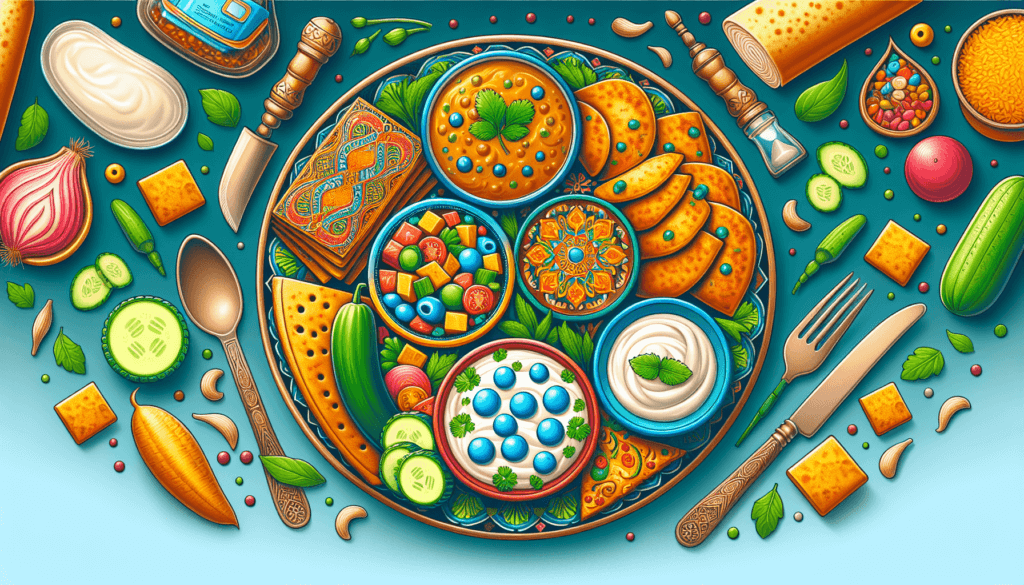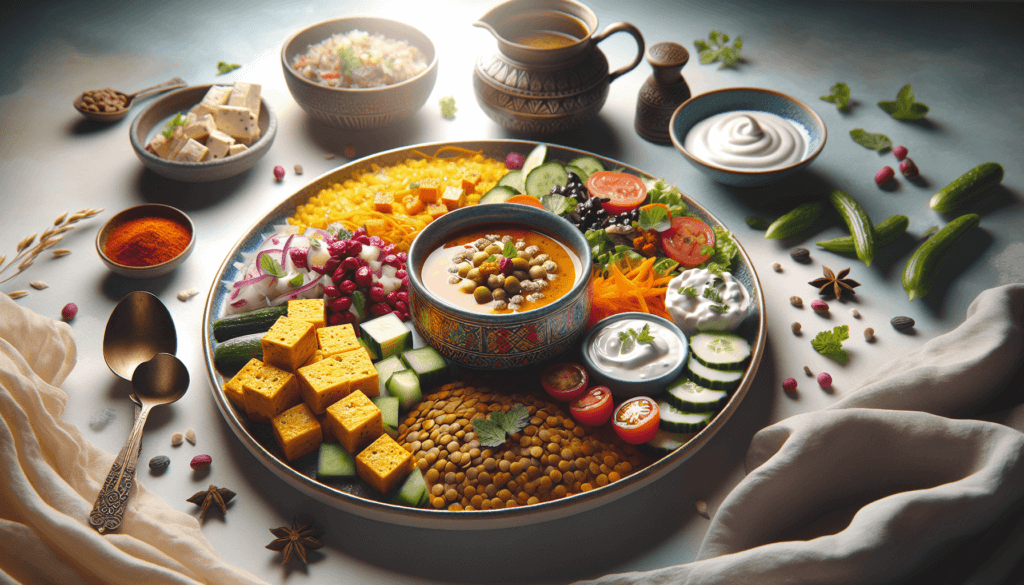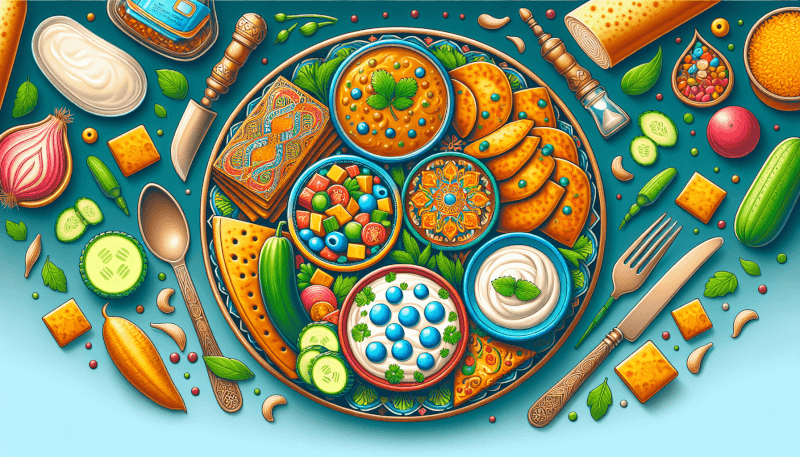If you’re someone who loves the vibrant flavors of Indian cuisine and also happens to have diabetes, you may have wondered how these two can coexist. The good news is that with some adjustments and mindful choices, you can still enjoy delicious Indian food while effectively managing your blood sugar levels. In this article, we will explore the relationship between Indian food and diabetes, offering insights into healthy food choices, portion control, and strategies for balancing the indulgence of Indian flavors with the requirements of diabetic-friendly eating. So, get ready to savor the rich aromas and spices with confidence, knowing that you can still embrace the wonders of Indian cuisine on your diabetes journey.

Introduction to Indian Food and Diabetes
Indian cuisine and its diversity
Indian food is known for its rich flavors, vibrant colors, and diverse range of ingredients. With its wide variety of dishes, Indian cuisine offers a unique culinary experience that tantalizes the taste buds. From spicy curries to aromatic biryanis, Indian food is an amalgamation of flavors, textures, and aromas that have captivated people around the world.
Prevalence of diabetes in India
India has been grappling with a significant rise in diabetes cases over the years. According to the International Diabetes Federation, India ranks second in the world in terms of the number of adults with diabetes. The reasons behind this alarming prevalence are multifactorial and include genetic predisposition, sedentary lifestyle, and the adoption of a Westernized diet high in refined sugars and unhealthy fats.
Impact of diet on diabetes management
Diet plays a crucial role in managing diabetes effectively. Making informed choices about the types and quantities of food you consume can help regulate blood sugar levels, maintain a healthy weight, and prevent complications associated with diabetes. For individuals with diabetes, understanding the key components of the Indian diet and how to incorporate them in a balanced manner is of paramount importance.
Understanding Diabetes
Definition of diabetes
Diabetes is a chronic metabolic disorder characterized by elevated blood sugar levels. It occurs when the body fails to produce enough insulin (a hormone that regulates blood sugar) or effectively utilizes the insulin it produces. This results in abnormal glucose metabolism and can lead to a range of complications if left unmanaged.
Types of diabetes
There are three main types of diabetes: type 1, type 2, and gestational diabetes. Type 1 diabetes is an autoimmune condition where the body’s immune system destroys insulin-producing cells in the pancreas. Type 2 diabetes, the most common form, typically develops due to a combination of genetic and lifestyle factors. Gestational diabetes occurs during pregnancy and usually resolves after childbirth.
Causes and risk factors
The causes of diabetes are complex and multifaceted. Type 1 diabetes is believed to be caused by a combination of genetic susceptibility and environmental triggers, while type 2 diabetes is closely linked to lifestyle factors such as obesity, physical inactivity, and poor dietary choices. Other risk factors include family history, age, ethnicity, and certain medical conditions like polycystic ovary syndrome (PCOS).
Key Components of Indian Diet
Rich in whole grains
The Indian diet is predominantly based on whole grains, such as wheat, rice, millets, and oats. These complex carbohydrates provide a steady release of energy, preventing sudden spikes in blood sugar levels. Whole grains are also high in fiber, which aids in digestion, promotes satiety, and helps regulate blood sugar levels.
Variety of spices and herbs
Indian cuisine is renowned for its extensive use of spices and herbs, which not only enhance the flavors but also offer numerous health benefits. Spices like turmeric, cinnamon, fenugreek, and cumin have been studied for their potential to improve insulin sensitivity, lower blood sugar levels, and reduce inflammation in the body.
Vegetable-centric meals
Vegetables form an integral part of traditional Indian meals, providing essential nutrients, fiber, and antioxidants. Incorporating a variety of colorful and seasonal vegetables into your diet can help manage diabetes by providing key nutrients while keeping calorie intake in check.
Pulses and legumes as protein sources
India boasts a wide range of pulses and legumes, including lentils, chickpeas, kidney beans, and black-eyed peas. These plant-based protein sources are not only low in fat but also high in fiber and essential minerals. Including pulses and legumes in your meals can help maintain stable blood sugar levels and promote overall health.
Incorporating dairy products
Dairy products like milk, yogurt, and paneer (Indian cottage cheese) are commonly consumed in the Indian diet. These dairy foods provide essential nutrients like calcium and protein. However, it is important to choose low-fat or skim options to minimize saturated fat intake, especially for individuals with diabetes.
Controlling Carbohydrate Intake
Choosing complex carbs over simple carbs
When managing diabetes, it is crucial to opt for complex carbohydrates that are digested more slowly and have a lower impact on blood sugar levels. Whole grains, legumes, and fiber-rich fruits and vegetables are excellent sources of complex carbs, while simple carbs like refined sugars and white flour should be limited.
Portion control and balancing
Controlling portion sizes plays a significant role in managing diabetes. Balancing the amount of carbohydrates, proteins, and fats on your plate helps avoid excessive calorie intake and maintain stable blood sugar levels. It is advisable to consult a healthcare professional or a registered dietitian to determine personalized portion sizes based on individual needs.
Impact of the glycemic index
The glycemic index (GI) is a measure of how quickly foods raise blood sugar levels. Foods with a high GI result in a rapid increase in blood sugar, while those with a low GI cause a slower and more gradual rise. Incorporating low GI foods like whole grains, legumes, and non-starchy vegetables can help regulate blood sugar levels and prevent sudden fluctuations.
Alternative flours for diabetes-friendly recipes
Traditionally, Indian cuisine uses a variety of flours like wheat, rice, and chickpea flour (besan). However, individuals with diabetes may consider exploring alternative flours such as almond flour, coconut flour, and flaxseed meal. These flour substitutes have a lower impact on blood sugar levels and can be used in various diabetic-friendly recipes.

Effect of Spices and Herbs
Health benefits of common Indian spices
The spices commonly used in Indian cooking not only add depth and flavor to dishes but also offer a myriad of health benefits. Turmeric, for example, contains a compound called curcumin, which has anti-inflammatory and antioxidant properties. Cinnamon has been found to help lower blood sugar levels and improve insulin sensitivity.
Regulation of blood sugar levels and insulin sensitivity
Several Indian spices and herbs have been studied for their potential to regulate blood sugar levels and improve insulin sensitivity. Fenugreek seeds, for instance, have been shown to lower fasting blood sugar levels and improve glucose tolerance. Cumin seeds may also aid in blood sugar control by enhancing insulin action.
Recommended spices for diabetes management
While many spices have potential benefits for individuals with diabetes, some stand out for their specific relevance. Turmeric, cinnamon, fenugreek, and cumin are often recommended due to their potential to help regulate blood sugar levels and improve insulin sensitivity. These spices can be incorporated into various dishes, adding flavor and health benefits.
Vegetarian and Vegan Options
Exploring plant-based Indian dishes
Indian cuisine offers a wide array of vegetarian and vegan options that can be suitable for individuals with diabetes. Dishes like dal (lentil soup), chana masala (chickpea curry), and baingan bharta (roasted eggplant) are not only delicious but also packed with nutrients and fiber. Embracing plant-based meals can lead to improved blood sugar control and overall well-being.
Substitutes for animal-based ingredients
For those following a vegetarian or vegan lifestyle, there are plenty of animal-based ingredient substitutes available. Paneer, a popular ingredient in Indian cuisine, can be replaced with tofu or tempeh, which are low in saturated fat and high in protein. Additionally, plant-based milk alternatives like almond milk or soy milk can be used instead of dairy milk.
Balancing nutrients in vegetarian diets
While vegetarian diets can provide ample nutrients and health benefits, it is essential to ensure a well-balanced intake of essential nutrients. Combining different sources of plant-based protein, such as legumes, tofu, and quinoa, is important to meet protein requirements. Also, incorporating a variety of vegetables, fruits, whole grains, and nuts can help provide a diverse range of nutrients.
Incorporating Protein
Importance of protein in a diabetic diet
Protein plays a crucial role in a diabetic diet as it helps maintain satiety, supports muscle health, and regulates blood sugar levels. Including adequate amounts of protein in each meal can help slow down the absorption of carbohydrates, preventing sudden spikes in blood sugar.
Choosing lean protein options
Opting for lean sources of protein is beneficial for individuals with diabetes. Skinless poultry, fish, tofu, and legumes are excellent choices as they provide protein without the added saturated fat found in high-fat meats. Incorporating plant-based proteins such as tempeh and seitan can also cater to the needs of individuals following a vegetarian or vegan diet.
Enhancing plant-based protein sources
Plant-based protein sources can be enhanced by combining complementary proteins to provide a wider range of essential amino acids. For example, combining lentils and rice creates a complete protein source. Including nuts and seeds in meals and using nut butters or chia seeds as toppings can also boost protein intake.
Traditional Indian protein-rich foods
Indian cuisine offers several protein-rich options that can be incorporated into a diabetic diet. Lentils (dal), chickpeas (chana), and kidney beans (rajma) are commonly used in Indian cooking and provide a good source of plant-based protein. Similarly, low-fat dairy products like yogurt and paneer are excellent choices for individuals looking for animal-based protein options.
Healthy Cooking Techniques
Reducing oil and fat content
Indian cuisine is often associated with the use of generous amounts of oil and ghee (clarified butter). However, for individuals with diabetes, it is important to reduce the consumption of unhealthy fats. Opting for healthier cooking oils like olive oil or canola oil, and using cooking spray instead of full-fat oils, can significantly reduce the overall fat content of meals.
Steaming, grilling, and baking
Incorporating healthier cooking techniques such as steaming, grilling, and baking can help reduce the need for excessive oil and fat in Indian dishes. Steamed vegetables retain their nutrients while grilling or baking meats and fish helps enhance flavors without adding extra calories.
Using non-stick cookware
Using non-stick cookware can minimize the need for excessive cooking oils. This allows for healthier cooking with reduced fat content. Non-stick pans also make it easier to cook without sticking, reducing the need for additional oil or ghee.
Avoiding deep-frying and excessive frying
Deep-frying is a common cooking method in Indian cuisine, but it can significantly increase the calorie and fat content of dishes. Individuals with diabetes should limit or avoid deep-fried foods altogether. Instead, opt for healthier alternatives like stir-frying or sautéing with minimal oil or using oven-baked versions of your favorite snacks.
Managing Portion Sizes
Understanding portion control
Portion control is essential for individuals with diabetes to manage their blood sugar levels effectively. It involves being mindful of the amount of food consumed in each sitting. Balancing the intake of carbohydrates, proteins, and fats while keeping portion sizes in check can help maintain stable blood sugar levels.
Plate method for balanced meals
The plate method is a widely used approach to creating balanced meals for individuals with diabetes. It involves visualizing your plate divided into sections: half of the plate filled with non-starchy vegetables, a quarter with lean protein, and a quarter with whole grains or starchy vegetables. This method helps ensure a well-balanced meal with controlled portion sizes.
Tips for controlling portion sizes
Controlling portion sizes can be challenging, but there are strategies that can help. Using smaller plates or bowls can create an illusion of a larger portion, leading to a feeling of satisfaction. Pre-measuring food portions, practicing mindful eating, and listening to your body’s hunger and fullness cues can also assist in managing portion sizes effectively.
Effect of overeating on blood sugar levels
Overeating can cause a rapid rise in blood sugar levels, leading to hyperglycemia and potential complications for individuals with diabetes. It is important to be mindful of portion sizes and avoid excessive consumption of high-carbohydrate and high-calorie foods. Finding a balance between enjoyment of food and portion control is key to managing blood sugar levels effectively.
Seeking Professional Guidance
Consulting a dietitian or nutritionist
Seeking guidance from a registered dietitian or nutritionist can greatly benefit individuals with diabetes. These professionals have extensive knowledge and expertise in creating personalized meal plans that cater to your specific dietary needs, lifestyle, and health goals. They can provide valuable advice and support in managing diabetes through optimal nutrition.
Creating personalized meal plans
A personalized meal plan developed by a dietitian or nutritionist takes into account your individual preferences, cultural background, diabetes management goals, and any dietary restrictions or allergies. By tailoring the meal plan to your unique needs, you can ensure a well-balanced diet that supports blood sugar control and overall health.
Monitoring blood sugar levels
Regular monitoring of blood sugar levels is crucial for individuals with diabetes. This helps identify patterns, track the impact of dietary changes, and make necessary adjustments to medication, if needed. Working alongside a healthcare professional, you can establish a monitoring routine that aligns with your specific diabetes management plan.
In conclusion, Indian cuisine has a diverse range of flavors and ingredients that can be incorporated into a diabetes-friendly diet. By understanding the key components of the Indian diet, controlling carbohydrate intake, incorporating spices and herbs, exploring vegetarian and vegan options, and managing portion sizes, individuals with diabetes can enjoy delicious and nutritious meals that support their diabetes management goals. Seeking professional guidance, such as consulting a dietitian or nutritionist, is essential for personalized meal planning and continuous monitoring of blood sugar levels to ensure optimal health outcomes. With the right knowledge and approach, Indian food can be a delightful addition to a well-balanced diabetic diet.


